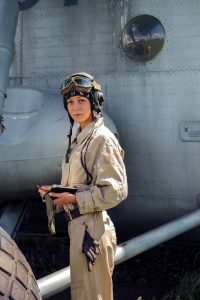[listen 8m 4s or read below]
Warning: If you dislike mangled, mixed and over-extended metaphors, please place this safety notice back in the pocket in front of you, remove shoes and exit swiftly (or parachute to possible co-pilot roles and responsibilities below).
Once you have navigated through the sea of ‘keep out’ and other similar warning signs and committed to dipping your toes into the shark-infested hybrid waters (Whatever you call it, we’re talking simultaneous live face to face and online teaching- Zoom or Teams mediated), you will know that number 1 in the advice chart is: ‘Get yourself a co-pilot’. But what is a co-pilot? What role could or should they play? Should they, like the kind of co-pilot you get on a plane, be able to land the thing if you were to become suddenly incapacitated? Is it a good idea to recruit students to do it? The following suggestions are based on doing the hybrid thing a few times a year over the last 3 or 4 years and a dozen or so times in the last 3 or 4 weeks.
Do you even need a crew? Or will a passenger do?
So, you have your pilot’s licence and you want to get into the cockpit asap. Surely the last thing you need is someone else twiddling knobs, making unauthorised announcements and looking better in their reflector shades? There are all sorts of reasons why flying anything from the new Boeing Jumbo Lecturehall to the Cessna 6-seater Skyhawk Seminar is likely to be something you want or are obliged to do alone. Assuming for a moment that your airline (read: institution, faculty/ department) can fund a co-pilot then there are plenty of reasons why you might benefit from having someone by your side. If the plane is no private jet and there’s not the reserves to dip into you might still want to find a way to get someone in and give them a shiny badge with ‘co-pilot’ written on it, whether or not they could land the thing themselves. Whatever the size of your aircraft this is more than the flying you may (or often not) have been trained to do. Suddenly you’re being asked to carry on flying but also remote control a car (perhaps with all your loved ones in it) on the motorway 30,000 ft below you. How helpful a co-pilot can be will depend on a range of factors:
- Their own professional training and subject expertise
- Whether they are paid
- Whether this is likely to be a one off event or a sustained new way of travelling
- All the variables you can imagine
So in an ideal world an equivalently trained co-pilot is optimal (a close colleague perhaps to get you through the first time), an in-training colleague (such as a PGTA), a student quality reviewer (UCL colleagues look out for an announcement on this soon) or even one or more of the passengers (sorry, students) you are flying that day. Please note: In the latter case, you will need to think through the implications, limit or spread the load and note that co-pilots have reported intense concentration requirements leading to them not processing what the pilot has been saying. Whatever your situation and whoever you are able to work with the following are roles that you might want to consider for the co-pilot. Most important is to agree and delineate roles prior to the session starting.

Ready to fly?
(possible) Co-pilot roles and responsibilities
Most of the following would not be reasonable to expect from a student volunteer and ALL of them would be unreasonable for any co-pilot, however well they were remunerated! Where students are asked to help maintain connection between online and in-person participants it may be prudent not to think in terms co-piloting given the necessary limits to what they can be expected to do. In those circumstances it may be wise to have a few students with different responsibilities (eg. One simply signals when an online hand is raised, another paraphrases in chat the in-person contributions).
Pre-flight checks
- Helping to check equipment works ahead of a session
- Role playing as a student in physical or online spaces to identify potential issues (from font size on display which may be reduced due to additional elements needed on screen to audio levels of mics and speakers)
- Sending reminders, fielding questions about joining instructions and/ or seeding persistent back-channel (if used)
- (Immediately before take off) Participate in final checks, guide students to seats (for optimal acoustics), assist with registration
- Post re-assuring notes in online space and/ or backchannel- tell remote attendees when to expect pilot’s mic to be unmuted
- Reminding in-person students to mute both mics AND speakers on their devices if they access the remote participation link (note: the more in-person students who join the online space, the harder it is to set up breakout groups)
- Have links to all in-session and post-session resources to hand to paste into chat or backchannel
- Serving drinks is not advised
Take-off
- Welcoming in chat the online participants, by name if possible if group is not too large
- If appropriate, facilitate connections between the two modalities- e.g. Volunteer students in the physical space waving over your shoulder into your webcam and the online particpants wave back.
- Asking in chat if audio can be heard when pilot turns on their mic and be the point of contact if any technical issues are experienced
- Reiterating participation protocols for contributions from online participants in chat (e.g. Raise electronic hand); how invitations to speak will work
- Sharing links to or guidance about other channels of participation (e.g. Mentimeter participation link; PowerPoint Live presentation link and how to start simultaneous translation; guidance on starting subtitles in online platform)
Climb & Cruise
- Flag ‘hands up’ to pilot at appropriate junctures/ pre-agreed times
- Paraphrase in-room contributions in chat, especially where audio issues are known. Identifying the contributor (even initials only) helps online participants keep track of things
- (If agreed) respond to questions arising in chat or at least acknowledge that questions have been received/ seen
- Summarise/ theme remote contributions and questions
- Open/ close and monitor breakout rooms
- Send messages to breakout rooms that mirror in person instructions
- In text-only collaborative spaces, add comments if appropriate and smooth facilitation between remote and in-person students
Descent and landing
- Give opportunity to pose questions and commit to sharing responses if not addressed in session
- Share links to resources, activities, follow up work or tasks to be completed ahead of future sessions
- Seek evaluative comments (on connection/ access/ accessibility etc.)
- Signpost preferred media for communications between live events and ahead of next session and where/ how to access any session recordings
What have I forgotten? What have you tried that smooths hybrid/ hyflex sessions with or without a co-pilot? Let me know!
“The Hitchhiker’s Guide to the Galaxy has this to say on the subject of flying. There is an art, it says, or, rather, a knack to flying. The knack lies in learning how to throw yourself at the ground and miss.” Douglas Adams







